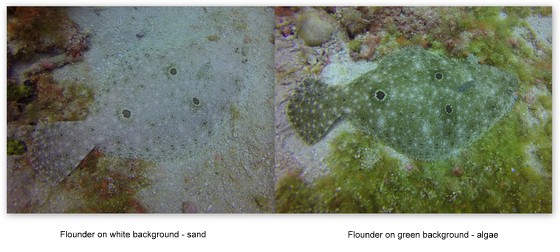![]()
- Coral Restoration Foundation
- Archaeological Diving Experience
- Cayman Brac - What a Trip!
- Free BBQ, Free Dives, Prizes
- The Beauty of Boynton
- Dry Tortugas National Park - Part 2
- The Secrets of Sea Creatures that Change Color
- Shark Junction
- Diver's Safety Sausage - Part 1
- Newsletter Delivery Options
- Email or Address Change?
- T-Shirts For Sale
- ADA Guidelines and Policies
Still Time To Join the Coral Restoration Foundation Coral Planting Experience
 The Active Divers
Association is hosting a joint coral restoration event
on Saturday, September 17. Join us and the Coral
Restoration Foundation (CRF) for an educational and
fulfilling volunteer experience learning how to
prepare, grow, harvest, and replant corals on our reef
eco-system. This full day program includes classroom
training in the morning, followed by a catered lunch,
and a two-tank dive trip visiting the CRF coral
nursery, and out-planting baby corals onto the reefs.
Cost is $130 per diver and includes 2016 membership in
the Active Divers Association (required), all diving,
tanks/weights, lunch, CRF donation, boat fees, and
materials.
The Active Divers
Association is hosting a joint coral restoration event
on Saturday, September 17. Join us and the Coral
Restoration Foundation (CRF) for an educational and
fulfilling volunteer experience learning how to
prepare, grow, harvest, and replant corals on our reef
eco-system. This full day program includes classroom
training in the morning, followed by a catered lunch,
and a two-tank dive trip visiting the CRF coral
nursery, and out-planting baby corals onto the reefs.
Cost is $130 per diver and includes 2016 membership in
the Active Divers Association (required), all diving,
tanks/weights, lunch, CRF donation, boat fees, and
materials.
Learn more about the experience and sign up today. For questions, contact Lon at lon@diverlon.com or 305-251-4975.
![]()
Join ADA For Our First Archaeological Diving Experience
--by Rachel Davis, John Davis and Lon Von Lintel
ADA has partnered with the Florida Public
Archaeological Network (FPAN) to present our First
Annual Underwater Spanish Wreck Diving Weekend. The
Florida Public Archaeology Network, FPAN, is a
statewide network with regional centers dedicated to
public outreach and assisting local governments and
the Florida Division of Historical Resources, in order
to promote the stewardship and protection of Florida’s
archaeological resources. Through creating and
developing partnerships, FPAN strives to engage the
public with Florida’s rich archaeological history.
For divers with a romantic spirit, an inquisitive nature, or an appreciation of history, there is nothing quite like exploring a sunken Spanish Galleon in the Florida Keys! ADA is proud to offer this unique opportunity to learn and explore a living piece of our history.
Here are the details: Who: ADA members interested in learning about and diving on Spanish wrecks. What: 2-1/2 day course of classroom, pool training, and Spanish wreck diving. When: September 9-11, 2016 Where: Upper Florida Keys (Key Largo and Tavernier) Cost: $199 per diver includes classroom training fees, boat fees, pool fees, recording and mapping and photography equipment and tools. Free 2016 ADA membership included for those not already members. Not included - scuba equipment and tanks (can be rented from Capt. Slates), meals, and lodging.
![]()
 Eleven ADA divers
enjoyed what many are calling the best international
trip the club has done in recent years! Dan and I had
been to Cayman Brac many years ago and a few
hurricanes visited the island since we had been there.
We knew the diving was spectacular but what we didn’t
know is that the resort had been almost completely
rebuilt and also recently remodeled. But what was
really amazing is how accommodating all of the staff
were at the resort- from the dive operations all the
way to the front desk. We had an all inclusive food
package and the food was terrific at all three meals
every day.
Eleven ADA divers
enjoyed what many are calling the best international
trip the club has done in recent years! Dan and I had
been to Cayman Brac many years ago and a few
hurricanes visited the island since we had been there.
We knew the diving was spectacular but what we didn’t
know is that the resort had been almost completely
rebuilt and also recently remodeled. But what was
really amazing is how accommodating all of the staff
were at the resort- from the dive operations all the
way to the front desk. We had an all inclusive food
package and the food was terrific at all three meals
every day.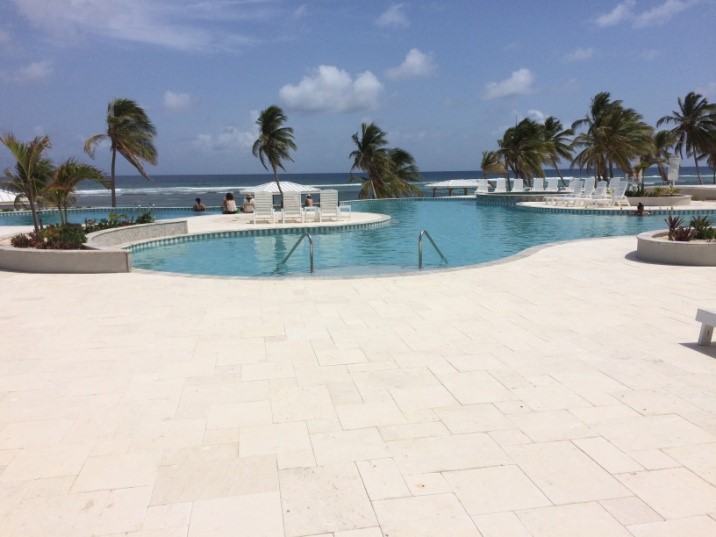
Speaking of the dive operations, they had three large
Newton dive boats which are great to begin with but
they also did “valet diving” so that once we handed
them our gear we never had to lift it for the rest of
the trip. We would simply take our fins and masks to
platforms at the rear of the  boat and they would
bring the rest of the gear to us and help us get it
on. And they really worked had to make sure that the
dive site we went to had the best visibility and
lowest current available. All of the divers did the 12
dives that came with the trip but Rachel and John
Davis are the “iron divers” of the trip with a total
of 19 dives for the week.
boat and they would
bring the rest of the gear to us and help us get it
on. And they really worked had to make sure that the
dive site we went to had the best visibility and
lowest current available. All of the divers did the 12
dives that came with the trip but Rachel and John
Davis are the “iron divers” of the trip with a total
of 19 dives for the week.
There were lots of photos taken and if you visit our FaceBook page you can see the photo album with all of the terrific pictures. It will be hard to top this trip for next year but if you have a place in mind send it to me at diverdaryl@bellsouth.net and it will be added to our list to check out as we plan for 2017.
![]()
When: Saturday, Oct 8, 2016
Who: ADA members, prospective members, family and friends.
Where: John U Lloyd State Park, Jetty Pavillion, 6503 N. Ocean Drive, Dania Beach, Florida 33004 1.5 miles north of Sheridan St. on A1A
Time: Park opens at 8:00 AM. Meet for beach dive at 9:00 AM, BBQ at noon.
MUST BE PRESENT TO WIN RAFFLE PRIZES. MUST RSVP TO WIN PRIZES.
Bring Your Dive gear for Sale or Swap!!
Call or email Lon at 305-251-4975 or lon@diverlon.com to sign up, deadline October 5th for RSVP. For beach diving, bring all your own gear and a dive flag if you have one. Bring lobster gear as this is a great lobster spot. Bring that license too, the FWC seem to find this as one of their favorite hang outs. Or if you made it to 65+, no license is needed. The reef is about 100 yards off shore. It’s a great surface swim out. That is your warning. Or dive in close and enjoy the reef. The pavilion has covered shelter, very nice bathroom, showers, and changing room. We will have the BBQ and raffle, rain or shine, unless a hurricane threatens. BBQ will include burgers, dogs, chicken, extras and all drinks. A small fee is charged to enter the park ($4 for single occupancy vehicles, $6 for 2-8 persons per vehicle), free parking at the pavilion. Non-ADA members and non-family members may attend but will be asked to contribute $10 for the BBQ. They may also dive, but are not part of the ADA dive group and not eligible for prizes
![]()
Close to Home: The Beauty of Boynton Beach
ADA divers may have noticed the location of Boynton Beach showing up on the dive schedule more frequently this year. We have three dives planned for Boynton Beach - including one coming up over Labor Day weekend on Saturday, September 3rd.
Situated half-way between Fort Lauderdale and West Palm, Boynton Beach is still relatively undiscovered and the sites are far less visited than many South Florida dive sites. The reefs of the Boynton and Delray Ledges systems are in pristine condition, hosting an impressive bio-mass of fish and other sea creatures including sharks, eels, turtles, and rays. In fact it's not uncommon to see pods of dolphins following alongside the boat. If your captain is nice enough, he may even stop the boat and let you snorkel around with them, as we did recently with Starfish Enterprise charters.
![]()
You may have wondered how I previously wrote about the Dry Tortugas and there was no mention of diving. Well there is diving, but not on any of the trips to Fort Jefferson. There is snorkeling there however. Diving in the Dry Tortugas has to be done properly by liveaboards.
There are several that make the trip. The diving is
pristine and the lobsters are huge because of the
distance from the mainland.
A cold front in 1976 came thru it wiped out 96 \% of the branching corals. Most of the park is now patch reefs. Lionfish have also added to the parks diving problems. However that is being addressed by management.
The club has made several trips to the park but none lately and none are planned that I am aware of. So, you are on your own to discover and report what your experience has been. The boats require permits to dive here so it should be spectacular. Do it and tell us about your experience.
![]()
While diving Boynton Beach recently on the 4th of July we noticed a flounder on the sandy bottom. We almost didn't see him because he was so well camouflaged. His body was exactly the color of the sand, complete with subtle brown speckles. We observed him move a few feet away into a bed of algae, where his body color miraculously changed to a deep green hue to match the algae-covered bottom. He disappeared into the algae as effectively as he had disappeared into the sand. This change was immediate. So we began to wonder how these amazing creatures are able to change their body color so perfectly and rapidly. This article is our attempt to understand what causes this miracle of nature.
"Many thousands of color-changing cells called chromatophores just below the surface of the skin are responsible for these remarkable transformations. The center of each chromatophore contains an elastic sac full of pigment, rather like a tiny balloon, which may be colored black, brown, orange, red or yellow. If you squeezed a dye-filled balloon, the color would be pushed to the top, stretching out the surface and making the color appear brighter—and this is the same way chromatophores work. A complex array of nerves and muscles controls whether the sac is expanded or contracted and, when the sac expands, the color is more visible. Besides chromatophores, some cephalopods also have iridophores and leucophores. Iridophores have stacks of reflecting plates that create iridescent greens, blues, silvers and golds, while leucophores mirror back the colors of the environment, making the animal less conspicuous," per Fox Meyer, Smithsonian National Museum of Natural History.
So now that we understand how they change color, we then wondered how do they know what color to become in order to camouflage themselves?
"To produce these changes within the skin cells, light stimuli is received through the eyes at the retina and passed through nerves to specialised skin cells. The colouration is a response to the ratio of reflected to incident light directed at the retina, and is generally a mix of the inputs from both eyes. While a flounder with one eye is still able to change colour effectively, a fully blind flounder cannot simulate the background in shade, colour or pattern." Dan Bayley, MarLIN at the Marine Biological Association.
We have also observed this phenomenon with octopi in Belize, as well as with groupers in the Cayman islands. Octopi can change their texture as well as their color for more effective camouflage. Here is a link to an amazing video of an octopus that is perfectly camouflaged on a coral head. He turns bright white when he is startled by the diver. Watch it here.
![]()
The purpose of the safety sausage is to make diver's location visible from long distances on the surface. Many boat captains and/or dive shops require all divers to carry this devise for good reason. A diver's head bobbing in choppy seas is very difficult for boat crews to locate at long distances. All agree that being visible not only allows your boat to find you, but remember, other boaters need to see you as well. Being struck by other boaters is a real and present danger. But there are so many choices to choose from, which is best and how much do they cost? I am glad you asked. First thing to consider is size. Yes size does matter is this case. Length should be at least 6 feet. The objective is to elevate something visible above the waves. If the waves are 3-4 feet, then a 6 foot devise is needed. Next consider width. I recommend at least 9 inches. Again bigger is better. Colors range from yellow to green to orange. My experience tells me yellow is best. Prices range from $20-$30 for a simple oral inflated no frills devise.
Next time, Diver's Safety Sausages part 2
![]()
Photos taken on a GoPro
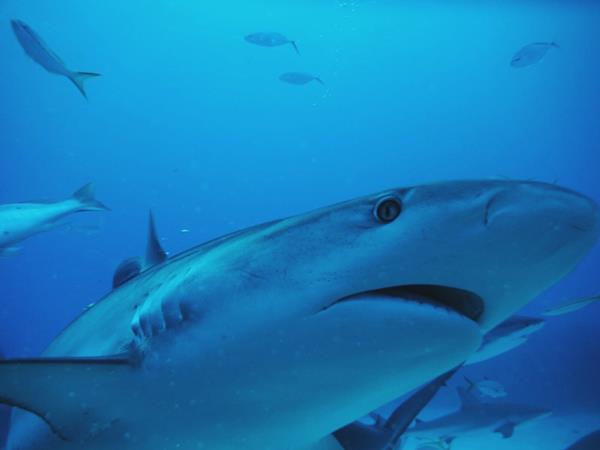 At 2:30pm, just 10
minutes off the sandy beaches of the Bahamas we
arrived at our destination, Shark Junction. Our group
consisted of 10 guests, 1 camera man, 2 safety divers,
and at last 1 shark feeder.
At 2:30pm, just 10
minutes off the sandy beaches of the Bahamas we
arrived at our destination, Shark Junction. Our group
consisted of 10 guests, 1 camera man, 2 safety divers,
and at last 1 shark feeder.
The visibility underwater was at its finest as I made my way down 45 feet. Greeted by more than 15 Bahamian Reef sharks I swam to the feeding area. It is very important to keep your movements slow and steady in order to create a safe environment for you and the sharks. While observing these magnificent creatures, I noticed that some had hooks on their mouths. This was one of the most incredible dives I have yet experienced. It helped me clearly understand how harmless sharks can be.

![]()
If so, please email or call us with your current information. you may send an email to: Dr. Dan Baeza, Membership Chair at dmbaeza@bellsouth.net. You can also call Dan at 954-260-8225 and leave a message with your new contact information.
Show your pride in the best dive club anywhere! Sizes small, medium, large, xlarge, xxlarge. Some tank tops available also. All shirts are $10 each. CALL LON AT 305-251-4975 AND PLACE YOUR ORDER TODAY!. Lon will deliver it to you on your next dive.


![]()
Want your newsletter delivered via snail-mail? Contact the webmaster and request a printed copy. Be sure to put "ADA Newsletter" in the subject.
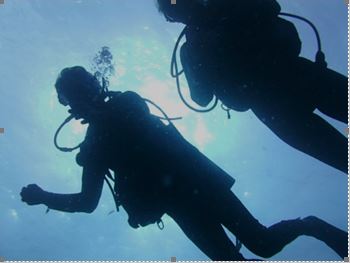

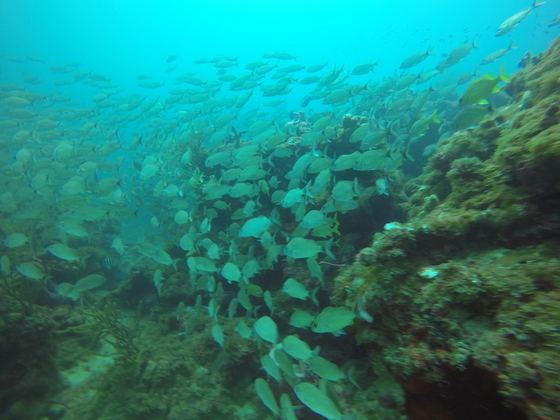 The profile of the
dives is 50-70 feet, making Nitrox valuable to
extend bottom time to get in a full hour on each
dive. The ledges are the most impressive, with a
hoards of marine life gathering around and under the
beautifully sculpted crags. Large maroon vase
sponges adorn the area and serve as additional
hiding places for smaller reef creatures. The ledge
system is easy to navigate, as the current is nearly
always running south, parallel to the ledge system.
Unlike further north in the West Palm area the
current in Boynton Beach is always mild to moderate,
thus making it easy to navigate diagonally across
the current to locate the ledge, or observe the
amazing creatures wherever they may go.
The profile of the
dives is 50-70 feet, making Nitrox valuable to
extend bottom time to get in a full hour on each
dive. The ledges are the most impressive, with a
hoards of marine life gathering around and under the
beautifully sculpted crags. Large maroon vase
sponges adorn the area and serve as additional
hiding places for smaller reef creatures. The ledge
system is easy to navigate, as the current is nearly
always running south, parallel to the ledge system.
Unlike further north in the West Palm area the
current in Boynton Beach is always mild to moderate,
thus making it easy to navigate diagonally across
the current to locate the ledge, or observe the
amazing creatures wherever they may go.